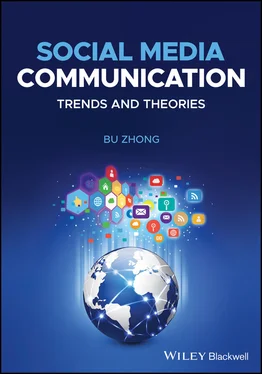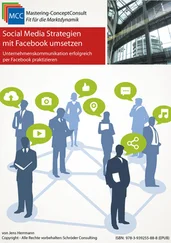(Ellison & boyd, 2013, p. 158)
In other words, social media are the means of interactions among users, organizations, and businesses, in which users create and share information in virtual communities. In this sense, social media have relevance not only for users, organizations, and businesses, but also human society as a whole.
Applications that have developed within and around social media are endless in number and functionality, but all make sharing and searching information online easier. The result is an enormous amount of information that can be easily created, shared, distributed, promoted, and searched. Social media became an important source of information in the era of internet civilization. As a result, social media help create an endless number of niche social communities where members can gather around common topics, resulting in social movements from raising awareness of climate change in a local community to the Arab Spring, a revolutionary wave of demonstrations, and protests spreading to 19 Arab countries.
For individuals or businesses that do not invest time in understanding what social media are and their implications in society, they will have to make it up in the near future. Researchers contend that like other forms of new media, social media can be best understood and analyzed when they are positioned as ICT applications in various social contexts (Cheong et al., 2012; Lievrouw & Livingstone, 2006). For a better understanding of social media functions, we must ask: What is technology?
The notion of technology is not foreign to human beings. Today, people tend to think about technology in terms of such novel innovations as VR (virtual reality), 3D printers, or drones, but technology is also as old as a stone axe and as simple as paper making in the history of human civilization (see Thurlow et al., 2004). In this view, social media are just one of the new applications in a long line of technologies invented by human beings.
We all know what technology is, or we think we do. The same term, nonetheless, may mean different things to different people. Before we review the role of technology, it is helpful to define what technology is. A widely cited definition of technology is from the International Technology Education Association (ITEA) in the United States:
Broadly speaking, technology is how people modify the natural world to suit their own purposes. From the Greek word techne , meaning art or artifice or craft, technology literally means the act of marking or crafting, but more generally it refers to the diverse collection of processes and knowledge that people use to extend human abilities and to satisfy human needs and wants.
(ITEA, 2007, p. 2)
Technology thus can be best understood as an intrinsic human faculty, which is one of human beings’ basic, even defining characteristics (Heidegger, 1977). Heidegger noted that technology and sciences are distinct, but they strongly influence each other, and technology is often the cause of scientific breakthroughs. To Heidegger, there are several essential facts about what technology is; i.e., technology, as a human activity, is a means of transforming nature; technology is the art of solving practical problems, not an application of abstract theory. In essence, the technological act of creation is the act of revealing the truth out of the many possibilities offered by nature.
In human history, technological innovations have had wide-ranging effects across numerous domains of society. One of the most significant outcomes of the progress of technology is its impact on social activities and the environment these activities have. For example, the progress of information and communication technology has brought long-lasting consequences to people’s interpersonal relations, and access to and affordability of information.
Human civilization has gone through numerous changes in history, and in recent years ours has been profoundly affected by the diffusion of ICT. Today, people still need to communicate by phone or meet others face-to-face, but social media are providing yet one more means of engaging with people in society. If used effectively, social media can give all of us a greater choice in how we communicate and do business in the world. To better understand the underlying mechanism of social media, it is important to review the role of technology in the four eras of human civilization.
Four Eras of Human Civilization
One powerful approach to analyzing the role of technology is to treat the progress of technology as a succession of rolling waves of change. This requires us to focus less on the continuities of technology progress and more on the discontinuities or breakthroughs in it. The approach is particularly helpful in identifying key patterns of technology changes as they emerge and unfold so that we can take full advantage of them.
In this book, technology refers to information and communication technologies (ICT), which may also be used interchangeably with media technologies. Each passing day provides new and imperative reasons to review the role of information and communication technology in the twenty-first century. Social media powered by the advances in information and communication technology have brought a radical and pervasive change to human society. The basis of the change is the observation of the broad use of social media, mobile technology, or ICT as a whole. The technology behind social media has impacts comparable to Gutenberg’s improvement of printing technology, resulting in a broad social use of the technology by dramatically reducing the cost of using it. The changes caused by social media, however, are not well understood by either average users or practitioners, including journalists, marketing managers, or public relations personnel.
Technology, an intrinsic human faculty, is assumed to play a pivotal role in the process of humanity development (Calder, 1962). The progress of human civilization driven by technology may be loosely divided into four eras, i.e., the eras of agricultural, industrial, information, and internet civilization (see Figure 2.1). It must be noted that the four broad divisions are proposed in the hope of dividing the complex history of civilization into more easily understood phrases, in which the role of technology in each era of civilization can be better apprehended. Technology is, in essence, a truth revealing, creative activity. It is also, for the most part, a problem-solving activity (Heidegger, 1977). Polish scientist Andrzej P. Wierzbicki (2007) perceptively comments on the role of technology in human society, noting that “No matter how we define humanity, we would stop being human if we stopped creating technology” (p. 400).

Figure 2.1 Four eras of human civilization. (Illustration by Moxin Qian).
1. Agricultural Civilization
The first era of human civilization emerged due to the rise of agriculture, which is “the first turning point in human social development” (Toffler, 1980, p. 29). The agricultural civilization should not be taken as a social structure consisting of discrete objects and distinctive events, but rather as a series of cumulative social changes moving at uneven speeds, during which hunting and gathering were transformed into agriculture – the cultivation of animals and plants for food and clothing.
The era of agricultural civilization dates back to the Neolithic period (around 10,000 B.C.), starting a long period of social transition from the pre-agricultural period, characterized by a Paleolithic diet, to an agricultural period characterized by a diet of cultivated food and domesticated animals (Barker, 2006). Leaving behind the hardships of nomadic life, human beings began the journey of civilization by settling down in fixed locations as soon as they knew how to gather seeds from plants and grew them periodically. In an agricultural community, farming was more economical and less labor-intensive than hunting, fishing, or searching for fruit in the wild. The development of farming provided people with fixed meals each day for the first time in history. The new lifestyle enabled people to live longer and healthier lives, and be less vulnerable to nature, especially when it turned harsh.
Читать дальше













